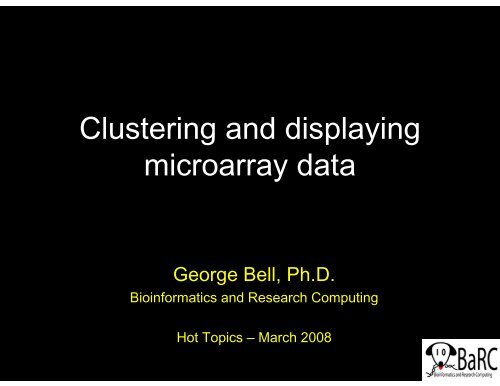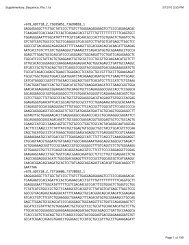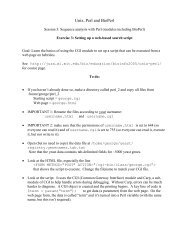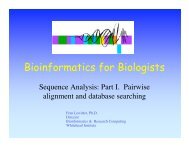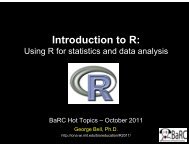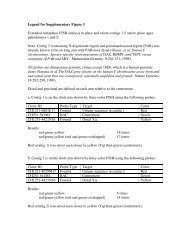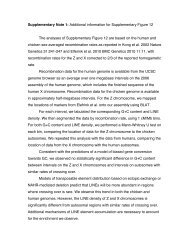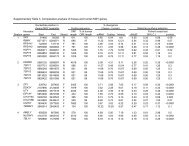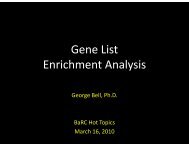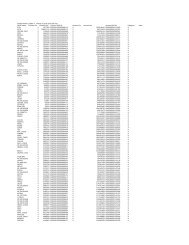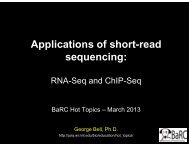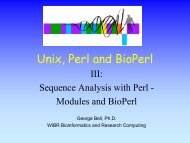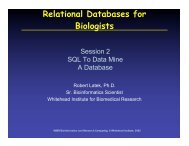Clustering and displaying microarray data - Bioinformatics and ...
Clustering and displaying microarray data - Bioinformatics and ...
Clustering and displaying microarray data - Bioinformatics and ...
You also want an ePaper? Increase the reach of your titles
YUMPU automatically turns print PDFs into web optimized ePapers that Google loves.
<strong>Clustering</strong> <strong>and</strong> <strong>displaying</strong><br />
<strong>microarray</strong> <strong>data</strong><br />
George Bell, Ph.D.<br />
<strong>Bioinformatics</strong> <strong>and</strong> Research Computing<br />
Hot Topics – March 2008
Why<br />
• Explore a large amount of expression or other<br />
<strong>data</strong><br />
• Get experiment-wide look at interesting subset<br />
of <strong>data</strong><br />
• Visually identify patterns for further analysis<br />
• Order genes <strong>and</strong>/or experiments in a sensible<br />
way<br />
• Split genes <strong>and</strong>/or experiments into a predefined<br />
number of groups
Why not<br />
• <strong>Clustering</strong> is not a substitute for rigorous<br />
statistics<br />
• <strong>Clustering</strong> cannot identify<br />
– differentially expressed genes<br />
– profiles that are correlated with a reference profile<br />
• Any <strong>data</strong> – even noise – can be clustered<br />
• <strong>Clustering</strong> is not an essential step for most<br />
analyses
Where to get the <strong>data</strong><br />
Day et al., 2007<br />
Celsius project<br />
Only Affymetrix<br />
sources shown
Types of <strong>data</strong><br />
• Single-color arrays (mainly Affymetrix)<br />
– Data reported as expression values<br />
– Raw values or log2-transformed values (RMA;<br />
GCRMA)<br />
• Two-color arrays<br />
– Data reported as expression ratios<br />
– Raw ratios or log2-transformed ratios
<strong>Clustering</strong> with Cluster 3.0<br />
• Based on original clustering program by Michael<br />
Eisen<br />
• Code updated by Michiel de Hoon<br />
• Runs on Windows, Mac, <strong>and</strong> Linux<br />
• Free from<br />
http://bonsai.ims.u-tokyo.ac.jp/~mdehoon/software/cluster/software.htm<br />
• Hierarchical, k-means, SOMs<br />
• Other option for large <strong>data</strong>sets:<br />
– XCluster, a comm<strong>and</strong>-line tool by Gavin Sherlock
Getting Cluster 3.0
Cluster <strong>data</strong> import<br />
• Minimal matrix (text, not Excel format)<br />
Probe<br />
Amygdala<br />
Heart<br />
Kidney<br />
Liver<br />
Lung<br />
1000_at<br />
0.85<br />
0.19<br />
-0.92<br />
-0.32<br />
-0.27<br />
1009_at<br />
0.02<br />
0.44<br />
0.32<br />
0.53<br />
-0.80<br />
1014_at<br />
-0.25<br />
0.17<br />
-5.83<br />
-5.83<br />
0.93<br />
1030_s_at<br />
-0.25<br />
0.13<br />
-2.09<br />
0.21<br />
1031_at<br />
-0.35<br />
-0.19<br />
-0.22<br />
-5.00<br />
• Matrix with annotation <strong>and</strong> cluster weights<br />
GeneID<br />
NAME<br />
GWEIGHT<br />
Amygdala<br />
Heart<br />
Kidney<br />
Liver<br />
Lung<br />
EWEIGHT<br />
0<br />
0<br />
1<br />
1<br />
1<br />
1000_at<br />
MAPK3<br />
1<br />
0.85<br />
0.19<br />
-0.92<br />
-0.32<br />
-0.27<br />
1009_at<br />
HINT1<br />
1<br />
0.02<br />
0.44<br />
0.32<br />
0.53<br />
-0.80<br />
1014_at<br />
POLG<br />
1<br />
-0.25<br />
0.17<br />
-5.83<br />
-5.83<br />
0.93<br />
1030_s_at<br />
TOP1<br />
0<br />
-0.25<br />
0.13<br />
-2.09<br />
0.21<br />
1031_at<br />
SRPK1<br />
0<br />
-0.35<br />
-0.19<br />
-0.22<br />
-5.00
Data filtering<br />
• Why filter<br />
– Noise (unexpressed or uninteresting genes) can hide signal<br />
– A complete <strong>data</strong>set is too much to visually process<br />
• What are you looking for<br />
– Differentially expressed genes<br />
– Most variable genes<br />
– Most interesting profile<br />
(expression pattern)<br />
• Select list of genes of interest<br />
• Select set of genes with GO<br />
annotation of interest<br />
• Do in spreadsheet or Cluster<br />
(“Filter Data” tab)
Transforming <strong>data</strong><br />
• Do in spreadsheet or Cluster<br />
(“Adjust Data” tab)<br />
• Common methods<br />
– Log-transformation<br />
– Converting values into ratios<br />
– Centering:<br />
• value – mean (row or column)<br />
• value – median (row or column)<br />
– Many normalization methods (from elsewhere)
<strong>Clustering</strong> goals <strong>and</strong> caveats<br />
• Potential goal: organize a set of <strong>data</strong> to show<br />
relationships between <strong>data</strong> elements<br />
• With <strong>microarray</strong> analysis: genes <strong>and</strong>/or chips<br />
• Most <strong>data</strong> does not inherently exist in clusters<br />
• Most effective with optimal quantity of <strong>data</strong><br />
• Interpretation of <strong>data</strong> in obvious clusters: is it<br />
filtered<br />
• <strong>Clustering</strong> vs segmenting
Hierarchical clustering<br />
• Agglomerative, unsupervised analysis<br />
• Steps<br />
1. Create an all vs. all distance matrix<br />
2. Fuse closest objects<br />
3. Compare fused object to all others<br />
4. Repeat steps 2-3 until one<br />
inclusive cluster is created<br />
• Can be performed on<br />
genes <strong>and</strong>/or arrays<br />
• Efficiency = O(n 2 m)<br />
• Need to select:<br />
– Similarity Metric<br />
– <strong>Clustering</strong> method
Measuring similarity<br />
between profiles<br />
• Similarity (distance) metric is an important choice<br />
when comparing genes <strong>and</strong>/or experiments<br />
• What are you trying to group<br />
350<br />
300<br />
Expression values<br />
250<br />
200<br />
150<br />
100<br />
50<br />
Gene A<br />
Gene B<br />
Gene C<br />
Gene D<br />
Gene E<br />
Gene F<br />
0<br />
Exp1 chip1 Exp1 chip 2 Exp2 chip1 Exp2 chip 2 Exp3 chip1 Exp3 chip 2
Common similarity metrics<br />
• Pearson correlation<br />
– Measures the difference in the shape of two curves<br />
– modifications:<br />
• uncentered correlation: for offset profiles, coefficient < 1<br />
• absolute correlation: opposite profiles cluster together<br />
• Euclidean distance: multidimensional Pythagorean<br />
Theorem<br />
– Measures the distance between two curves<br />
• Nonparametric or Rank Correlation<br />
– Similar to the Pearson correlation but <strong>data</strong> values are<br />
replaced with their ranks<br />
– Ex: Spearman Rank, Kendall’s Tau<br />
– Good idea if distribution of <strong>data</strong> is not normal<br />
– More robust (against outliers) than other methods
<strong>Clustering</strong> methods<br />
How can groups of objects be represented<br />
How is distance measured to a cluster of objects<br />
• Single linkage (b)<br />
– minimum distance<br />
• Complete linkage (r)<br />
b<br />
– maximum distance<br />
• Centroid linkage (p)<br />
– distance to “centroid” of group<br />
p<br />
• Average linkage (x)<br />
– average distance<br />
Weighting<br />
– GWEIGHT, EWEIGHT<br />
x = mean (b,y,r)<br />
r<br />
y<br />
2<br />
1
Cluster <strong>data</strong> output<br />
• For hierarchical clustering by genes <strong>and</strong> arrays, 3<br />
output files are created:<br />
– .cdt (“clustered <strong>data</strong> table”)<br />
– .gtr (“gene tree”)<br />
– .atr (“array tree”)<br />
• All are tab-delimited text <strong>and</strong> can be opened as a<br />
spreadsheet<br />
• Create your own ‘cdt’ file <strong>and</strong> bypass Cluster 3.0:<br />
– Tab-delimited text<br />
– First 2 columns are gene identifiers<br />
Gene ID<br />
Symbol<br />
Amygdala<br />
Heart<br />
Kidney<br />
Liver<br />
Lung<br />
1000_at<br />
MAPK3<br />
0.85<br />
0.19<br />
-0.92<br />
-0.32<br />
-0.27<br />
1009_at<br />
HINT1<br />
0.02<br />
0.44<br />
0.32<br />
0.53<br />
-0.80
Representation of clustered <strong>data</strong><br />
• Hierarchical clustering produces a dendrogram(s)<br />
showing relationships between objects<br />
• Order of leaves: 2 N-1 choices<br />
• How can objects be<br />
partitioned into groups<br />
– k-means clustering<br />
– self-organizing maps<br />
– How many clusters (k)<br />
• Are the <strong>data</strong> really hierarchical<br />
• Original distance matrix may be informative
Visualizing clustered <strong>data</strong><br />
with Java TreeView<br />
• Based on original clustering program by Michael<br />
Eisen<br />
• Code updated by Alok Saldanha<br />
• Runs on Windows, Mac, <strong>and</strong> Linux<br />
• Free from<br />
http://sourceforge.net/project/showfiles.phpgroup_id=84593
Getting Java TreeView<br />
• http://sourceforge.net/project/showfiles.phpgroup_id=84593
Java TreeView main view
Java TreeView: settings
Java TreeView: exporting images
Displaying other types of <strong>data</strong>
Demo


